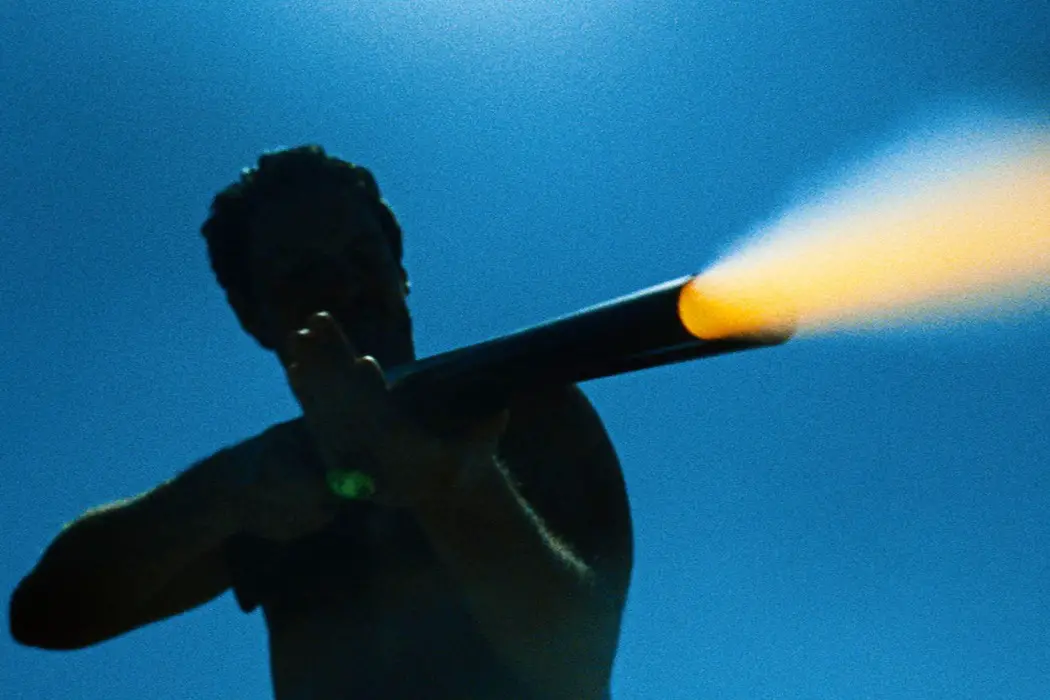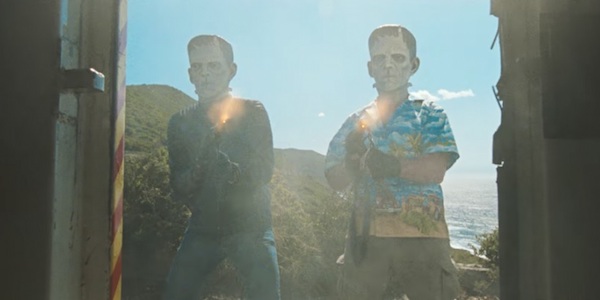LET THE CORPSES TAN: A Vibrant, Visceral & Stylish Pistol Opera

Movie lover & Los Angeles-based writer. BA in Film Criticism…
When directors Hélène Cattet and Bruno Forzani set out to make a movie, they typically don’t buckle down and craft a conventional motion picture with a cohesive narrative. As witnessed in their previous efforts, 2009’s Amer and 2013’s The Strange Color of Your Body’s Tears, the filmmaking duo deal in pure abstraction. Their work is characterized by bold coloring and lighting schemes, dynamic editing flourishes, and heavy splashes of smoldering sensuality and bloody violence. Their previous films also established their interests in giallo, paying homage to the works of Dario Argento and Mario Bava while carving out their own niche in the horror subgenre.
Cattet and Forzani’s last two films were exceptionally stylish yet undeniably challenging, appreciated more for their cinematic craftsmanship than proficiency in storytelling. Their latest, Let the Corpses Tan, is no exception, except here the focus has shifted from giallo to spaghetti westerns as Cattet and Forzani orchestrate a feature-length shootout for the ages. Vibrant, visceral, and flat-out brilliant, Let the Corpses Tan frequently thrills and excites, with directors chasing down every filmmaking impulse and scratching every creative itch they can muster.
A Little Less Conversation, a Little More Action
Adapted from the French novel “Laissez bronzer les cadavres“ by Jean-Patrick Manchette and Jean-Pierre Bastid, Let the Corpses Tan largely eschews any semblance of a story in favor of delivering a pure sensorial experience. What does pass for a plot (and I do use that term loosely) concerns a motley crew vacationing in a labyrinthian stone fortress somewhere off the coast of the Mediterranean Sea. Chief among them is Luce (a fierce Elina Löwensohn), an artist who enjoys her days painting and basking in the sun, often joined by author Bernier (Marc Barbé), and attorney Bisorgueil (Michelangelo Marchese).
Trouble brews in paradise when a gang of bandits, led by the indomitable Rhino (Stéphane Ferrara), pull off a daring heist, slaughtering a police motorcade to make off with a shipment of gold bars. Seeking refuge at Luce’s resort, Rhino’s scent is picked up by a pair of motorcycle cops, who trace the outlaws back to the stronghold. Their arrival is greeted with gunfire, leaving one Motorcycle Cop (Hervé Sogne) left alive behind enemy lines, outnumbered and outgunned as Rhino and his men move in for the kill. Matters are further complicated when Bernier’s wife, son, and nanny arrive at the estate, forced civilians into the line of fire as cop and criminals let the bullets fly.

Let the Corpses Tan announces its intentions right off the bat. We’re introduced to the world of Luce, who’s first seen firing her pistol wildly at a paint-splattered canvas, furiously chewing a cigarette a la Clint Eastwood’s Man With No Name. Shot primarily in close-ups (establishing shots are seemingly a luxury for Cattet and Forzani) to soak in every sun-kissed detail, Luce is revealed to be a force of a nature, reveling in the anarchy of her design. “Don’t you appreciate a little gunfire before breakfast?” she playfully queries.
Cattet and Forzani do away with dialogue for much of the picture, paring it down to only the absolute necessities, preferring to let the images tell their story. It’s a strategy that worked well with their previous efforts, utilizing the helmers’ gifts for visual storytelling and indelible imagery. Entire sequences are carried out wordlessly, with an early highlight being Rhino’s assault on the armored gold transport, detailing the criminal’s brusque professionalism and penchant for violence, carrying out his mission ruthlessly and efficiently.
Style as Substance
Once the Motorcycle Cop, clad in an all-leather, crinkly suit (a Cattet and Forzani specialty) arrives on the island, all hell breaks loose, literally and figuratively, as the filmmakers go for broke unleashing every cinematic trick in the book to construct their mayhem. Editing is the lifeblood of the picture, offering an intoxicating array of cuts and transitions that underscore the chaos of the firefight. Time itself is also manipulated, jumping backwards and forwards to key moments in the action to let them play out from an alternate angle.
Cattet and Forzani treat the cinema as their formal playground, pushing their technical dexterity to the limits as they let their imaginations run wild. Cinematography by Manuel Dacosse is appropriately sunbaked and gorgeous, and the film also features a wicked sound design, detailing every click, c*ck, and reload of each firearm, and soaking in every squish, splash, and spurt of a bullet piercing a body. Samplings of Ennio Morricone’s famous scores also creep in intermittently on the soundtrack.

The overall core of Let the Corpses Tan might ring a bit hollow, but the surfaces are consistently striking, with Cattet and Forzani more concerned with the details of a shot’s composition than telling a cogent story. Perhaps their most inspired sequences involve hallucinatory trips to the afterlife, where Death is embodied by a nude, gilded woman who lactates champagne and christens her shadowy followers with golden showers. It’s disgustingly amazing.
Let The Corpses Tan: Conclusion
For those who might be less inclined to enjoy such an abstract viewing experience, Let the Corpses Tan can grow exhausting during its final stretch, as characters switch loyalties, stakes are increased, and the sensorial overload threatens to become too much.
Thankfully, at only 90 minutes, Cattet and Forzani bow out at the perfect length before their film becomes overkill. It’s refreshing to see such exhilarating and original work, as the pair have truly crafted an incredibly wild and gonzo piece of art. Here’s to hoping they make many more of them.
What do you think? Does Let the Corpses Tan succeed on the strength of its visuals alone?
Let the Corpses Tan was released in limited theaters in the U.S. on August 31, 2018.
Does content like this matter to you?
Become a Member and support film journalism. Unlock access to all of Film Inquiry`s great articles. Join a community of like-minded readers who are passionate about cinema - get access to our private members Network, give back to independent filmmakers, and more.
Movie lover & Los Angeles-based writer. BA in Film Criticism & Media Theory from CSU Northridge. Unofficial Bond ally. Rhymes with “tequila.”













